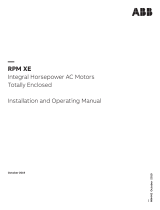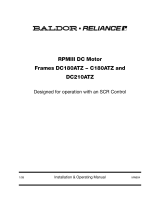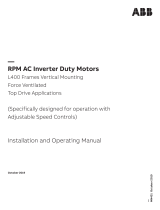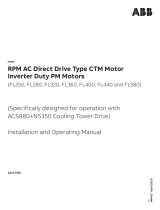
2 Installation & Maintenance MN416A01
WIRING
Connect the motor as shown in the connection diagrams.
If this motor is installed as part of a motor control drive
system, connect and protect the motor according to the
control manufacturers diagrams. Refer to MN408 for
additional details on lead marking. The wiring, fusing and
grounding must comply with the National Electrical Code
or IEC and local codes. When the motor is connected
to the load for proper direction of rotation and started,
it should start quickly and run smoothly. If not, stop the
motor immediately and determine the cause. Possible
causes are: low voltage at the motor, motor connections
are not correct or the load is too heavy. Check the motor
current after a few minutes of operation and compare the
measured current with the nameplate rating.
GROUNDING
Ground the motor according to NEC and local codes. In
the USA consult the National Electrical Code, Article 430
for information on grounding of motors and generators,
and Article 250 for general information on grounding.
In making the ground connection, the installer should
make certain that there is a solid and permanent metallic
connection between the ground point, the motor or
generator terminal housing, and the motor or generator
frame. In non-USA locations consult the appropriate
national or local code applicable.
ADJUSTMENT
The neutral is adjustable on some DC motors. AC motors
have no adjustable parts.
Noise
For specific sound power or pressure level information,
contact your local sales office.
VIBRATION
This motor is balanced to NEMA MG1, Part 7 standard.
BRUSHES (DC Motors)
Periodically, the brushes should be inspected and all
brush dust blown out of the motor. If a brush is worn
1/2, (length specified in renewal parts data), replace the
brushes.
WARNING: Guards must be installed for rotating
parts such as couplings, pulleys, external
fans, and unused shaft extensions,
should be permanently guarded to
prevent accidental contact by personnel.
Accidental contact with body parts or
clothing can cause serious or fatal injury.
Reassemble and seat the new brushes using a brush
seating stone. Be sure the rocker arm is set on the
neutral mark.
INSPECTION
Before connecting the motor to an electrical supply,
inspect for any damage resulting from shipment. Turn the
shaft by hand to ensure free rotation. Motor leads must
be isolated before the shaft will turn freely on permanent
magnet motors.
DRAIN PLUGS
One or more condensation drain plugs are provided on
each endplate for various motor mounting configurations.
For Washdown and totally enclosed, fan cooled or
non-ventilated motors, the plugs in the lowest portion of
the ends shields should be removed for operation (unless
the motor has special stainless steel drains). All drains
are located in the lowest portion of the ends shields.
MOUNTING
Mount the motor on a foundation sufficiently rigid to
prevent excessive vibration. Grease lubricated ball
bearing motors may be mounted with the feet at any
angle. After careful alignment, bolt motor securely in
place. Use shim to fill any unevenness in the foundation.
Motor feet should sit solidly on the foundation before
mounting bolts are tightened.
IP (Ingress Protection)
IP designations include two numerals, the first
characteristic numeral is for ingress solid bodies and
from dust. The second for ingress protection from liquid
- water. Motors marked less than IP23 require additional
protection from water.
GUARDING
After motor installation is complete, a guard of suitable
dimensions must be constructed and installed around the
motor/gearmotor. This guard must prevent personnel
from coming in contact with any moving parts of the
motor or drive assembly but must allow sufficient cooling
air to pass over the motor. If a motor mounted brake is
installed, provide proper safeguards for personnel in case
of brake failure. Brush inspection plates and electrical
connection cover plates or lids, must be installed before
operating the motor.
STARTING
Before starting motor remove all unused shaft keys and
loose rotating parts to prevent them from flying off.
Check direction of rotation before coupling motor to load.
The motor should start quickly and run smoothly and with
little noise. If the motor should fail to start the load may
be too great for the motor, the voltage is low or the motor
has been miswired. In any case immediately shut motor
off and investigate the cause.
ROTATION
To reverse the direction of rotation, disconnect and
lockout power and interchange any two of the three AC
power leads for three phase motors. For two-phase four
wire, disconnect and lockout power and interchange the
AC line leads on any one phase. For two phase three
wire, disconnect and lockout power and interchange
phase one and phase two AC line leads.
Maintenance Procedures
WARNING: Do not touch electrical connections
before you first ensure that power has been
disconnected. Electrical shock can cause
serious or fatal injury.
WARNING: Surface temperatures of motor enclosures
may reach temperatures which can cause
discomfort or injury to personnel accidentally
coming into contact with hot surfaces.
Protection should be provided by the user to
protect against accidental contact with hot
surfaces. Failure to observe this precaution
could result in bodily injury.
Lubrication Information
Refer to motor nameplate for recommended lubricant. If
none is shown, the recommended lubricant for
anti-friction bearings (-15°F to 120°) is POLYREX EM.
For Min Start Temp -100°F use AEROSHELL #7.
For roller bearings is ExxonMobil SHC-220.














